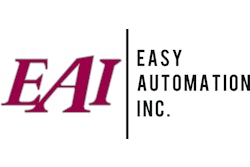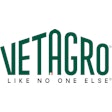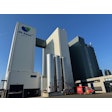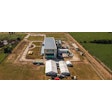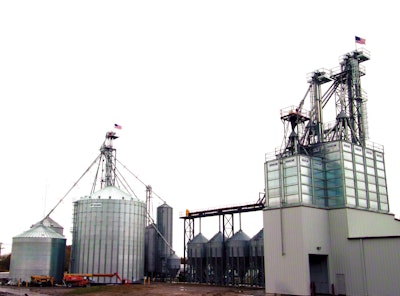
"It was very busy that week, full of cold and wet November days. I remember that it was overcast — everything was gray, including our moods.”
That’s how John Hornbostel, vice president sustainability/feed operations of Egg Innovations, described the days following a fire that destroyed the company’s Pierceton, IN, feed mill in the fall of 2014.
The 110-year-old building had worn many hats over the years. It was an apartment at one point and a water stop for steam trains before that. Thirteen years ago, Warsaw, IN-based Egg Innovations — America’s largest originator of 100% free range and pasture-raised eggs — purchased the old railway property and renovated it to produce feed for their 400,000 nearby layer hens.
Jennifer Ulerick, Egg Innovations’ feed mill/elevator manager, received the phone call at 2:30 in the morning when the building caught fire.
“It was pretty devastating, actually,” she said. “We spent a lot of time trying to get Pierceton running smoothly, bringing it into more modern times with technology. It was a devastating blow personally on top of what had to be done from a business standpoint.”
And from a business standpoint there was plenty to do: contact their insurance company, the state fire marshal and the farmers who relied on their organic, non-GMO feed.
Interruption plan in action
The cause of the fire was never determined, but it gave Egg Innovations’ management an unwanted opportunity to test their business interruption plan.
“We had a plan outlining the steps to follow when something happens — a fire, a tornado, anything that takes out a facility,” Hornbostel said. “Our plan kicked into high gear that day.”
In order to continue supplying eggs to their customers one of the company’s highest priorities was to source replacement feed for the affected egg farmers, which proved to be difficult because of their birds’ specialty feed needs.
With a lack of certified organic feed mills in a close proximity to Pierceton, Egg Innovations ended up sourcing feed from as far away as Pennsylvania, Ohio and Wisconsin.
With the fire extinguished, their employees unharmed, and a new source of feed procured, it was time to focus on the next part on the interruption plan — rebuilding.
Moving the mill
John Brunnquell, president of Egg Innovations, said the team looked at a number of factors and decided to rebuild the new mill about 10 miles north, on the site of its newly purchased non-GMO grain elevator in Cromwell, IN.
“One key factor in our decision to move was that this facility had 20 acres of open ground to expand on, and the community of Cromwell made it very clear to us through economic incentives that they wanted us here,” said Brunnquell.
Plus, it just made logistical sense to add the feed mill where they already had identity preserved grain storage capacity of 400,000 bushels.
“If we could have our feed mill right next to our grain storage rather than hauling the feed or the grain 10 miles every time, that option [to co-locate the facilities] became the clear winner,” Hornbostel said.
Construction and features
Egg Innovations commissioned Jackson Industrial Construction (JIC) of Concord, MI, to head up the project and Cedar, MI-based Sunfield Engineering consulted on process engineering.
The project had a tight budget and required a quick turnaround. To help achieve both goals, JIC salvaged some equipment from Pierceton to install at the new Cromwell location, including a soybean roaster, five grain bins and a few related pieces of equipment. The roaster serves a unique purpose in Egg Innovations’ feed operation.
“We roast our soybeans instead of buying soybean meal, which allows us to work directly with grain producers,” said Brunnquell. “This feed mill is entirely identity preserved and we only do non-GMO and organic, so being able to work directly with a farmer and removing a processor out of the middle gives us great flexibility.”
Aside from the salvaged equipment, everything about the new mill was a big upgrade from the old, completely manually operated location. The Cromwell facility can transport feed and grain via truck, rail or sea freight containers, whereas the Pierceton location only transported by truck. Meanwhile, the receiving, batching and storage systems are all controlled by Easy Automation software.
Other key features of the mill include four Chief bucket elevators (the main one, one for mash, one for ground grain and one for whole grain), a 25-ton/hour Andritz hammermill with a rotary feeder system, a 16-bin microingredient system by Easy Automation, a 2-ton batch mixer/surge hopper and takeaway conveyor by Scott Equipment and a 40-ton/hour Andritz feed cleaner. (See the complete equipment list below.)
Within 51 weeks from start to finish, the groundwork was completed, all the equipment was installed, and the mill was running test feed batches. It received organic certification on Oct. 28, 2015 — the day of its open house/grand opening ceremony.
It is the largest certified organic feed mill in Indiana and the second largest in the nation with the capability to manufacture 1,500 tons of feed/week (in one shift), once fully operational.
“We’re about five times larger now than we were at our old mill,” said Brunnquell. “Our productivity has gone up almost 400% by skipping several generations of technology with the automation system.”
Comparing the difference in efficiency from Pierceton to Cromwell is like night and day, commented Ulerick. For example, microingredients were previously added by hand with scoops and bucket scales. Today, their Easy Automation Microblend system automatically dispenses the correct amount of microingredients for each formulation using computer controls.
Even when running at full production capacity, the mill will employ a lean staff that includes only two people in operations — one for mixing feed while the other ensures raw materials move from the storage bins to the mill. Additionally, two staff members will manage quality assurance, compliance and record keeping for their organic and non-GMO certifications, and a senior manager will oversee and lead the team on a part-time basis.
The silver lining
“The quality of the feed has a direct correlation to the bird, and we have clearly seen performance improvements with the feed made here in Cromwell,” said Brunnquell. “We can measure that our birds are laying more eggs while we’ve decreased the cost of production.”
In retrospect, Brunnquell wouldn’t take back any of the rough road of 2014, as it led to one of the most progressive feed mill upgrades in its history.
“This is a great facility and we wouldn’t have gotten to this point in probably five years without having gone through the fire,” Brunnquell began. “But if you look at where we are today with new facilities like this feed mill, it certainly moved us — although painfully — generations forward in our position in the marketplace, in product quality and integrity.”





